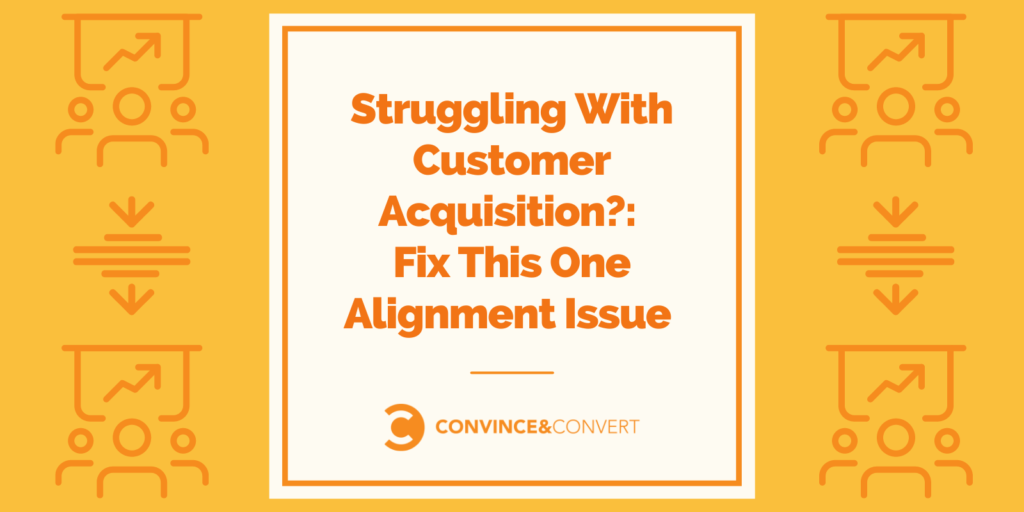 You are struggling to hit your acquisition targets—the marketing team is bringing in lots of hot leads but the sales team is struggling to convert them. Yet your marketing team is an award-winning one and your sales team is world cup worthy.
You are struggling to hit your acquisition targets—the marketing team is bringing in lots of hot leads but the sales team is struggling to convert them. Yet your marketing team is an award-winning one and your sales team is world cup worthy.
Where is the problem with your customer acquisition strategy? And what can be done about it?
Let’s dig a little deeper to understand what is making your team of A-players struggle to hit your acquisition goals?
Why Does Your Customer Acquisition Strategy Seem Broken?
There are many reasons why your customer acquisition strategy may not be working. But deep down, it’s due to one thing: the misalignment between your sales and marketing team.
Here’s how it translates into the organization.
Gap 1: Your sales and marketing teams are working on different funnels
In most companies, the marketing and sales teams work separately. Too often, marketers know too little about the customers and their dealings with the sales team.
SDRs work on cold emails and cold call random people, and marketers run campaigns to their target persona. As a result, each of these departments ends up creating an acquisition funnel based on the persona they have identified as their ideal customer profile.
This strategy is still used by many companies, even by some industry leaders, and it enables them to fuel their year-over-year growth.
Now, I bet you’re wondering what the problem is since this strategy seems to work.
Well, a study by the International Data Corporation revealed that B2B companies’ inability to align marketing and sales teams around the right workflows and technologies costs them about 10% or more of revenue per year.
In fact, when your sales and marketing departments function as standalone departments, efforts are put into tasks that are not very productive. For example, one study found that 50% of sales time is wasted on unproductive prospecting—either chasing unqualified leads or trying to convert leads that aren’t yet warmed up.
Another consequence of sales and marketing teams working with different funnels is a lack of understanding of the Ideal Customer Profile to target. For example, a lead that the marketing team deems qualified may be seen as unqualified by the sales team. A study by ReachForce showed that sales reps ignore 50% of marketing leads.
Other studies have shown that 60-70% of B2B content created is never used. In most instances, this is because the topic is irrelevant to the buyer audience. As you take it a step ahead, you realize that if the marketing team and the sales team worked together, it would have been easier for them to determine what content the marketing team should produce for lead nurturing and how to use it to warm leads.
Gap 2: Your sales and marketing teams are chasing different results
How can you achieve a shared goal if each team measures its success in different ways?
For clarity purposes, let’s assume you have a SaaS, and your annual goal is to grow sign-ups by 45+ percent.
Now imagine that the sales teams measured their success based on new free trial accounts, closed deals, and upsells. Meanwhile, marketing teams measured their success on lead quantity, quality, and brand awareness.
In this particular case, saying that you will fall short of your annual goal is just an understatement.
If there was alignment between the two teams, they would have agreed on what a quality lead means for the company and what is the average number of leads marketing needs to bring in before sales convert X amount of users.
If, for example, the metric shows that the sales team needs 15 leads to close 5 deals and that each of these leads should be SaaS companies with teams of 50 to 300, the marketing team will know where to focus their efforts and what to do in order to reach the common goal.
Similarly, the sales team will know better how not to fall short of the 5 out of 15 deals closed.
Why Aligning Sales and Marketing Is The Only Way to Fix Your Customer Acquisition Strategy
So with the gaps identified, it has become increasingly clear that the solution to bridging the gap is to align your sales and marketing teams.
Here are some reasons why.
It helps keep business to customer communications consistent
It happens more often than you think—the sales team calls the product one thing, but the marketing team uses another term to describe the same product.
For example, the sales team calls it a “Chatbot,” while the marketing team calls it a “Conversational Marketing Platform.”
Here is another example. The marketing team talks about “Collaborative Growth Platform”, while the sales team talks about “CRM”.
Admittedly, this can be confusing for potential and even existing customers, and it’s a living example of mismatched messaging.
Not surprisingly, it can cost you your first good impression and, as a result, a prospect may be less likely to trust you.
In fact, 21% of B2B marketers cite “giving the prospect a bad first impression of our company” as one of the most damaging factors resulting from misaligned marketing and sales.
That’s why one of the biggest benefits of aligning sales and marketing teams is consistent messaging.
The messaging used by your marketing team can now warm up prospects and set them up for the sales team to further reinforce those same messages. If the marketing messaging strikes a chord, the sales team can use it to close more business.
Failing this, you may end up with a siloed message, which can lead to a very confusing and inconsistent journey for your prospect.
21% of B2B marketers cite “giving the prospect a bad first impression of our company” as one of the most damaging factors resulting from misaligned marketing and sales. Share on XIf your prospects think they’re getting one thing based on what marketing is saying when the sales team is selling them something completely different, it will definitely hurt your bottom line.
So it’s important to make sure your message is consistent and relevant to your entire customer journey.
It creates a single customer journey
We discussed earlier that the foundation of the sales-marketing relationship is the conversion funnel. So when it comes to getting everyone on the same page, the best place to start is to get them to agree on the structure of the entire customer journey.
By doing so, you save your prospects from having a single branded customer experience instead of separate siloed experiences. As a result, everything is tied together as an experience—from the awareness stage at the top of the customer journey funnel to the brand loyalty stage.
It fosters a “marketing first” approach
Each department plays its own tune when your sales and marketing teams are misaligned. In such scenarios, prospects are less likely to respond positively to a cold outreach if they’ve never heard of you, and that can harm your reputation and your chances of closing the deal later on.
If both teams are aligned, it encourages a “marketing first” approach—meaning that marketers find prospects who have a specific problem and create content to help them solve that problem.
It all starts with the marketing team warming up and nurturing new leads by creating informational content about the product and selling the features and benefits by creating transactional content to fuel conversion. Then, when the potential customer prepares to make a decision, the sales team can take it from where the marketing left and close the deal.
It leads to a better way of assessing results
By aligning your sales and marketing teams with a common goal and the same KPIs, you have a great chance to see the synergy behind their work and analyze how your organization is stacking up in both sales and marketing. In addition, you will be able to detect the shortcomings of your customer acquisition funnel and adjust not only certain parts but the whole funnel.

